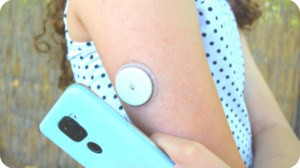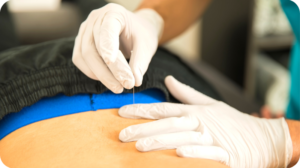Unlike other exercises, stretching is simple and easy, and can even be energizing. More importantly, a regular routine of full-body stretching helps ensure you maintain good balance as you age and can reinforce healthy musculoskeletal practices like proper posture when sitting and standing, and surefooted walking over uneven terrain.
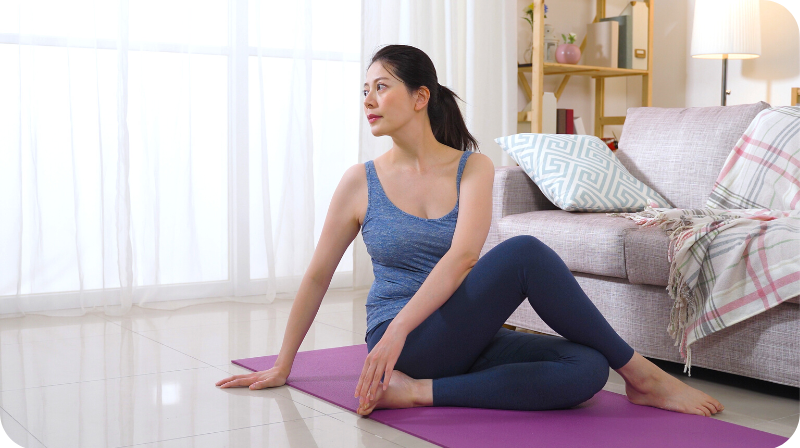
Make stretching a regular part of your exercise routine and you’ll reduce the risks of falls that can be so devastating as we age. You’ll also avoid the nagging injuries, aches, and pains so common as we grow older.
The five stretches here can all be done in less than a half hour, and will effectively stretch out every major muscle group in the body. They can be done all at once (the most convenient way) or broken up and performed at different times throughout your day.
A Stretching Routine
For the best results, stretch daily. Doing all of these stretches will take only a small commitment of time and effort and can actually feel rather refreshing. You can even repeat the routine two or three times a day (e.g., morning, noon, and right before bed) to maintain optimum suppleness.
Don’t stretch cold. The best time to do your stretches is right after a warm shower or bath, or a brisk walk, as your muscles have loosened somewhat.
- Hamstring. Although this stretch focuses on the muscle running behind your thigh, this is a good wake-up stretch for both the front and back of your legs. Keep a straight back and legs, bend at the waist, and slowly try to bring your face to between your knees. Once you’ve reached your limit (some pressure is okay, but no pain), hold for 10 seconds while breathing deeply in and out. Slowly return upright, and repeat two more times.

- Good Morning Stretch. This is great to do right in the shower, once you’re warmed up. Interlace your fingers behind your back. Point your chin up and, in one motion, raise up on your tiptoes and pull your hands down to open your chest and compress the upper back muscles. In addition to being a great stretch, this is also a good balancing exercise. Try to stay on your tiptoes for at least 5, and up to 10 seconds. Relax, shake it out, and do it again, 2 more times.

- Cat/Cow. This common yoga pose is immensely popular thanks to how good it makes the back feel. It can also aid digestion and relieve stress. Rest on your hands and knees on a surface that won’t bother your kneecaps, and slowly drop your head between your arms while you arch you back as high as it will go. Maintain breathing, while you hold the “cat” for 3 seconds. Now slowly return to a neutral flat back, head up and eyes forward. Slowly raise your chin up and out as you pull your abs and spine down to create an inverted curve. Remembering to breathe, count to 3, and then return to neutral. Do at least 5 stretches both ways, and always remember to breathe deeply and slowly throughout the stretches.

- Piriformis stretch. This unusual stretch provides a different type of tension relief in the back. Where many back stretches elongate or compress the spine, the piriformis stretches the supporting muscles on either side, improving torso stability. Sit on the floor with one leg straight out and your back and neck held straight. Bend and cross the opposite leg over the straight leg, catching the side of the foot on the straight-leg knee. Hold the straight-leg-side arm straight out, pressed firmly against the raised knee. Slowly and carefully twist the torso so that you are looking backwards (or as close to backwards as you can without pain). Use the opposite arm as a post to support your body. Hold for a count of 5 while breathing slowly and steadily, and then carefully unwind. Switch legs and arms, and repeat on the opposite side. Repeat the stretch 3 times on both sides.
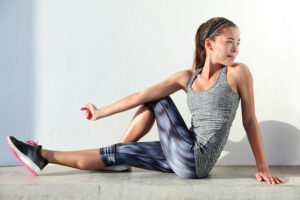
- Butterfly. A wonderful way to safely loosen up tight knees and hips, the butterfly is an exceedingly simple stretch. Sit flat on your butt (what yoga practitioners call the “seat” or the “sit bones”), with back straight and head upright. Hold the soles of your feet together so that your knees make butterfly wings. Lean forward slowly and use your elbows to press your knees out to each side. Keep pressing until you reach your limit, then hold for 3 seconds and release. Repeat 2 to 3 times. Straighten and shake out your legs before arising out of the stretch.
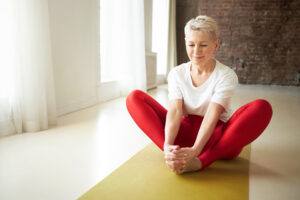
No matter what stretch you perform, never hold your breath. Breathe slowly and evenly as you stretch, and be aware of your limits. Stop if you feel any pain (discomfort, however, is okay). Although it is often easy and enjoyable, stretching is an active fitness exercise. That’s why you should consult your doctor before beginning a regular stretching routine, especially if you have a condition such as arthritis, compromised spinal disc, or other mobility issues.
